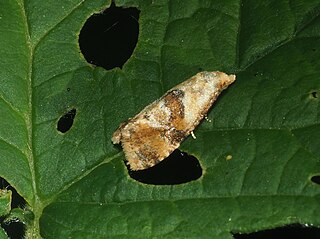
Phalonidia contractana is a moth of the family Tortricidae. It is found in southern Europe, Dalmatia, Macedonia, Hungary, Romania, Bulgaria, Greece, Ukraine, southern Russia (Sarepta), Uralsk, Turkey, Kuldscha, Afghanistan, Kashmir, Lebanon, China, Iran, Pakistan and Kyrgyzstan.

Cochylichroa atricapitana, the black-headed conch, is a moth of the family Tortricidae. It is found in China (Xinjiang) and the eastern Palearctic and most of Europe.

Gynnidomorpha alismana, the water plantain conch, is a moth of the family Tortricidae. It was described by Ragonot in 1883. It is found in most of Europe, except Spain, Switzerland, most of the Balkan Peninsula and Ukraine. Further east it is found across the Palearctic to China and Korea. It is found in riverine and other watery habitats.

Gynnidomorpha vectisana, the small saltern conch, is a moth of the family Tortricidae. It was described by Henry Noel Humphreys and John O. Westwood in 1845. It is found in China, Japan, Korea, Ireland, Great Britain, Scandinavia, the Benelux, Germany, the Czech Republic, Slovakia, Hungary, Romania, Switzerland, Austria, Italy, Spain, the Baltic region and Russia. The habitat consists of saltmarshes, fens, wet heathland and freshwater marshes.

Cochylimorpha straminea, the straw conch, is a species of moth of the family Tortricidae. It is found in most of Europe, Morocco, Algeria, Tunisia, Asia Minor, the Palestinian territories, Iraq, Syria, Armenia, Transcaspia, Turkmenistan and Iran.
Phalonidia acrota is a species of moth of the family Tortricidae, the subfamily Tortricinae, and the tribe Cochylini. It is found in Peru.

Phalonidia aetheria is a species of moth of the family Tortricidae, the subfamily Tortricinae, and the tribe Cochylini. It is found in Brazil, in the states of São Paulo, Santa Catarina and Goias.
Phalonidia brevifasciaria is a species of moth of the family Tortricidae. It is found in Guizhou, China.
Phalonidia rotundiventralis is a species of moth of the family Tortricidae. It is found in Sichuan, China.
Phalonidia tenuispiniformis is a species of moth of the family Tortricidae. It is found in China.
Phalonidia scabra is a species of moth of the family Tortricidae. It is found in China and Korea.
Phalonidia melanothicta is a species of moth of the family Tortricidae. It is found in China and Japan.
Phalonidia lydiae is a species of moth of the family Tortricidae. It is found in China, Japan, Korea and Russia.
Phalonidia fraterna is a species of moth of the family Tortricidae. It is found in China, Korea and Russia.
Phalonidia chlorolitha is a species of moth of the family Tortricidae. It is found in China, Japan, Korea and Russia.
Phalonidia latifasciana is a species of moth of the family Tortricidae. It is found in China, Japan, Korea and Russia.

Phalonidia curvistrigana, the golden-rod conch, is a species of moth of the family Tortricidae. It is found in China, Japan, Korea, Russia and most of Europe. The habitat consists of woodland and scrubland.

Phalonidia lavana, or Platphalonidia lavana, is a species of moth of the family Tortricidae, the subfamily Tortricinae, and the tribe Cochylini. It has a terrestrial habitat and is found throughout North America. It does not have a Global Conservation Status Rank.

Phtheochroa inopiana, the plain conch, is a species of moth of the family Tortricidae. It is found in China, Iran, Japan, Mongolia, Russia and most of Europe. It has also been recorded in North America. The habitat consists of damp areas and woodland edges.

Phalonidia udana, or the loosestrife conch, is a European species of moth of the family Tortricidae, the subfamily Tortricinae, and the tribe Cochylini. It is widely distributed in the North Palaearctic but appears to be largely rare or missing in Central Europe. Previously, it was classified under the Phalonidia manniana taxon, but a recent effort to barcode all North European Lepidoptera revealed that P. udana and P. mannania are two distinct species.










